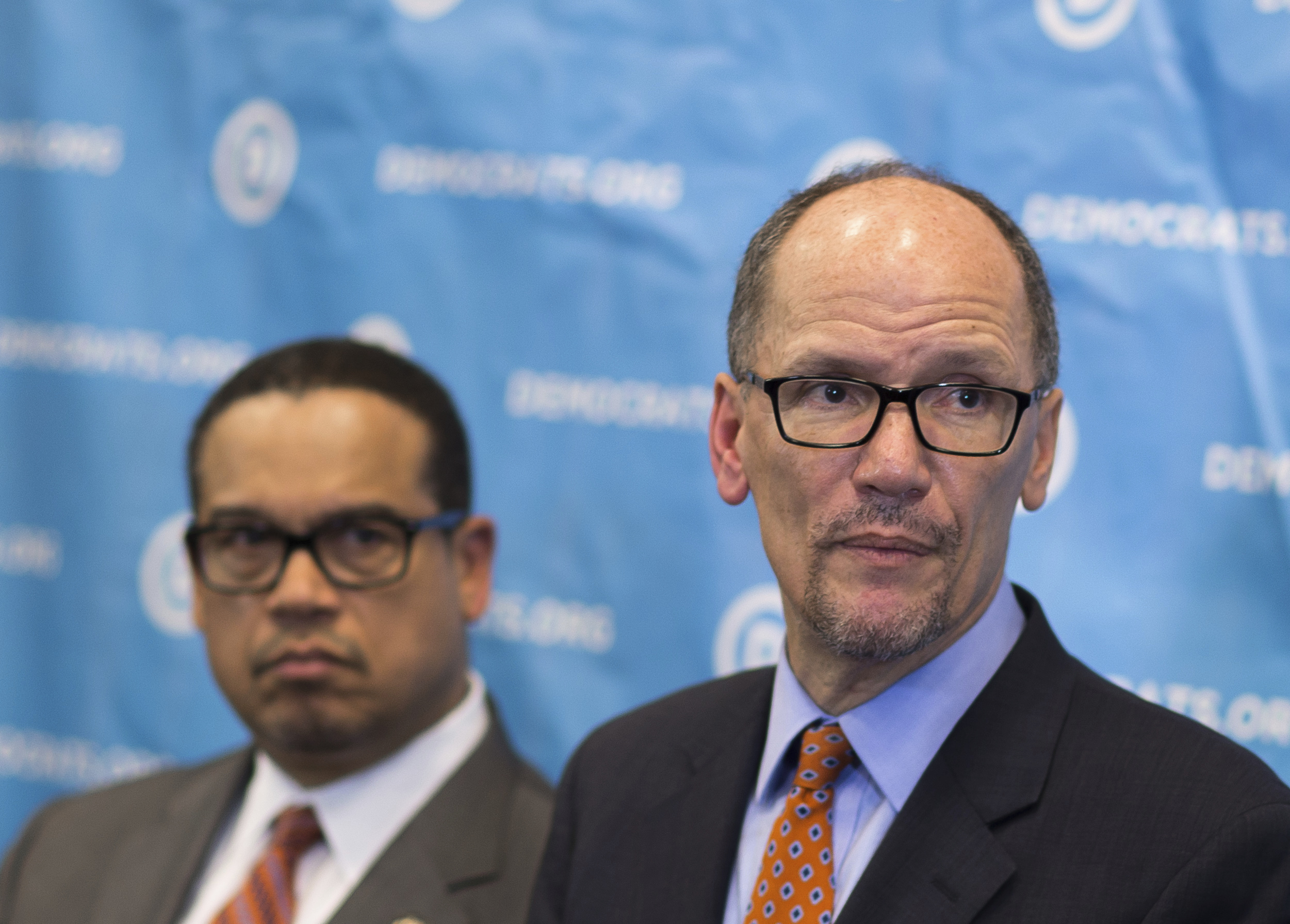The Democratic establishment would rather lose than allow the left to lead
Keeping Sanders Democrats down is priority number one for DNC elites


The Democratic National Committee narrowly elected former Secretary of Labor Tom Perez as its chairman on Saturday. The vote capped off what had become a fairly rancorous race between him and Keith Ellison, the left-wing House representative from Minnesota.
There are many lessons to take home here. But the key one is what this episode reveals about the thinking of the Democratic Party establishment. They would rather lose in 2018 and 2020 than allow the party's left wing to lead.
First, it's important to be clear about how this race went down. After Hillary Clinton lost in November, the party establishment was reeling and demoralized. Ellison stepped up the very next day and announced his candidacy for DNC chair. Though he is on the party left, he's always been reasonably friendly with almost everyone in the party, and he quickly rolled up endorsements from the left and centrist wings, from Bernie Sanders to Chuck Schumer. For a party at its lowest electoral ebb in eight decades, whose centrist nominee was beaten by the most unpopular opponent in the history of polling, it seemed like a reasonable compromise to unite both wings of the party.
The Week
Escape your echo chamber. Get the facts behind the news, plus analysis from multiple perspectives.

Sign up for The Week's Free Newsletters
From our morning news briefing to a weekly Good News Newsletter, get the best of The Week delivered directly to your inbox.
From our morning news briefing to a weekly Good News Newsletter, get the best of The Week delivered directly to your inbox.
But some party grandees, particularly Barack Obama and his allies, did not like Ellison as DNC chair, seeing him as too close to the left wing. They rooted around for someone to beat him, eventually settling on Perez. The establishment (including Obama himself) whipped hard for Perez behind the scenes. They placed anti-Ellison hit pieces around the press, dredging up his old and brief (and long since litigated to death) affiliation with the Nation of Islam. Democratic Party mega-donor and fanatical Israel partisan Haim Saban obligingly called Ellison an anti-Semite.
In a bitter irony, the smear campaign ended up being rather similar to that conducted by Clinton against Obama himself in the 2008 primary — only this time, it was against a real Muslim, and it worked.
Naturally, the centrist wing quickly ginned up some more reasonable-sounding excuses for running Perez, most often arguing that he and Ellison are very similar ideologically. If that were true, it raises question of why he had to run in the first place. But more importantly, it elides the biggest real difference between the two, which is that Perez is an Obama loyalist first and a (quite genuine) lefty second. He admitted as much during the DNC debate when he tried to explain why he supported the atrocious Trans-Pacific Partnership. Worse, he was a high-level staffer at the Department of Justice when the Obama administration decided to look the other way while millions of foreclosures proceeded based on forged documents, including over 1,000 illegal foreclosures on active-duty soldiers.
No, Perez is pretty obviously a stalking horse for the party elite. As to why they installed him as DNC chair, a variety of more compelling reasons come to mind: A belief that the party has to cater to Islamophobia to compete electorally, a petty dislike of Sanders Democrats, a desire to maintain control of the party machinery regardless of how disastrous recent political performance has been, and probably above all, a worry that Ellison would alienate the donor class.
A free daily email with the biggest news stories of the day – and the best features from TheWeek.com
This is basically the same class friction from the primary rearing its head. Hillary Clinton and Bernie Sanders had pretty much identical perspectives on racism, police violence, gender equality, LGBT rights, and so on (save perhaps that Clinton was a far more recent convert on every issue). Where they differed was on questions of class: Sanders' program was far to her left on infrastructure, social insurance, and taxation. This was reflected in the financial base of each campaign. Clinton personally took millions to give secret speeches to Wall Street banks, and spent half her campaign huddled with ultra-wealthy donors. Sanders excoriated her for those speeches, and raised money mostly from small-dollar individual donations.
One could imagine a post-election reckoning where the party's centrist wing conceded that the left would need to be meaningfully accommodated in order to take on Trump, especially given that bending over backwards to cater to the donor class turned out to be actively counterproductive. Clinton twisted herself into knots on trade policy, ran on fiddly tax credits, and refused to get behind popular policy like a $15 minimum wage. Trump, by contrast, ran on a classic right-populist combination of xenophobia, bigotry, jobs, and welfare for white people. Clinton's compromises allowed her to outspend Trump two to one, but she still lost. Perhaps it's time to restore some of that old Democratic New Dealism?
But what we're seeing now is that the centrist wing will not allow the left to hold any sort of leadership position if they can possibly prevent it. They'll get the most trivial of token positions — just as Schumer put Sanders in charge of party outreach, Perez moved to install Ellison as DNC deputy chair.
Now, it's certainly possible that Perez is not the merely the cat's paw for the centrist, donor-class wing he appears to be. But for now, after Clinton broke her campaign on the anvil of class, there is every sign the Democratic establishment, sitting atop the smoking remains of the party, will continue to do the exact same thing.
Ryan Cooper is a national correspondent at TheWeek.com. His work has appeared in the Washington Monthly, The New Republic, and the Washington Post.
-
 Homes with great fireplaces
Homes with great fireplacesFeature Featuring a suspended fireplace in Washington and two-sided Parisian fireplace in Florida
-
 Is $140,000 the real poverty line?
Is $140,000 the real poverty line?Feature Financial hardship is wearing Americans down, and the break-even point for many families keeps rising
-
 Film reviews: ‘The Secret Agent’ and ‘Zootopia 2’
Film reviews: ‘The Secret Agent’ and ‘Zootopia 2’Feature A Brazilian man living in a brutal era seeks answers and survival and Judy and Nick fight again for animal justice
-
 Has Zohran Mamdani shown the Democrats how to win again?
Has Zohran Mamdani shown the Democrats how to win again?Today’s Big Question New York City mayoral election touted as victory for left-wing populists but moderate centrist wins elsewhere present more complex path for Democratic Party
-
 Millions turn out for anti-Trump ‘No Kings’ rallies
Millions turn out for anti-Trump ‘No Kings’ ralliesSpeed Read An estimated 7 million people participated, 2 million more than at the first ‘No Kings’ protest in June
-
 Ghislaine Maxwell: angling for a Trump pardon
Ghislaine Maxwell: angling for a Trump pardonTalking Point Convicted sex trafficker's testimony could shed new light on president's links to Jeffrey Epstein
-
 The last words and final moments of 40 presidents
The last words and final moments of 40 presidentsThe Explainer Some are eloquent quotes worthy of the holders of the highest office in the nation, and others... aren't
-
 The JFK files: the truth at last?
The JFK files: the truth at last?In The Spotlight More than 64,000 previously classified documents relating the 1963 assassination of John F. Kennedy have been released by the Trump administration
-
 'Seriously, not literally': how should the world take Donald Trump?
'Seriously, not literally': how should the world take Donald Trump?Today's big question White House rhetoric and reality look likely to become increasingly blurred
-
 Will Trump's 'madman' strategy pay off?
Will Trump's 'madman' strategy pay off?Today's Big Question Incoming US president likes to seem unpredictable but, this time round, world leaders could be wise to his playbook
-
 Democrats vs. Republicans: who are US billionaires backing?
Democrats vs. Republicans: who are US billionaires backing?The Explainer Younger tech titans join 'boys' club throwing money and support' behind President Trump, while older plutocrats quietly rebuke new administration
